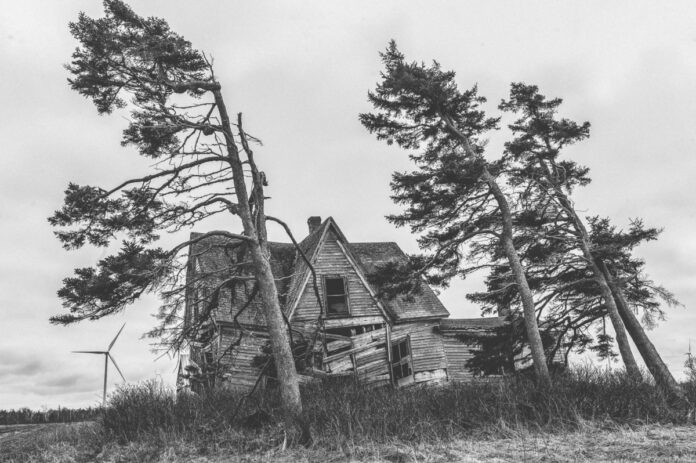
Monday and Tuesday were our coldest, windiest days Christmas of 2022, and an unusually cold period for November. Our local temps were in the teens and the windchill was well below zero. While we had some snow, it didn’t amount to much because the high winds blew it all away.
How windy was it? A tree in a neighbor’s yard blew down on Tuesday morning, blocking their driveway. One tarp on top of a stack of my firewood blew off and got stuck in a small tree. I recovered the tarp only because our motion-sensitive camera picked it up as it blew by and sent a photo to my phone.
We’ve had high winds before, but I’ve never lost a tarp. I had weighed it down with eight chunks of firewood and used two bungee codes to strap it in place. I don’t know if it was the power of the wind or the angle that made a difference, but all eight pieces of firewood were on the ground. Apparently, the wind got under there and tossed them off.
While our lights blinked several times, they stayed on. That surprised us, given the frequency with which we lose power around here. I’m guessing that with all the leaves off the trees, they were less likely to blow over now than in a summer storm. In any case, none fell on the power lines.
Colder Inside, Too

They built our log home use what RE called a D-logs. They provides the rounded look of a log cabin on the exterior without the need for chinking between logs. Each D-Log, as seen in the illustration, has two interlocking ridges to help hold the walls together and prevent wind and rain from getting through. When stacking the logs to form a wall, they place a layer of insulation between the logs to further aid them in keeping the warmth in and the cold out. This system works well, 98 percent of the time. The missing two percent is when it is very windy. Despite these tabs and the insulation, wind seems to push the cold through the walls.
Log homes also tend to contract a bit over time as the logs dry. To accommodate this, they build the windows and doorways with some room around them. This allows the house to settle around the door or window rather than onto it, preventing cracking the window or getting the door stuck. Of course, the extra room, which is covered up with and hidden behind the trim, allows wind to enter. Not an everyday wind, but a high wind, like we had this week. In other words, the wind outside howled and our house howled back.
We had to pile extra wood in the wood stove just to keep the basement in the low 70s. Upstairs, we lit the fireplace insert for the first time this year. Our firewood consumption jumped as a result. We’ve gone from bringing wood inside twice a week to three times a week for each woodburner.
And yet, later this week, we expect it to be in the 50s.
Outdoor Survival
I did not put on long underwear, wearing my fleece-lined pants instead. They kept my legs pretty warm. I also zipped the lining into my coat, something I only have to do a few times a year. As a result, I was puffy, but warm. I also took off my Glock in its OWB holster and carried a large bore revolver in a hunting holster. That holster is far easier to draw from when wearing heavy winter gear.
On my feet, I wore my boots with 400 grams of Thinsulate insulation and a thin pair of Realtree wool socks. My feet were plenty warm.
On my head, I traded my bright orange knit cap for one of those funny pilot hats with ear flaps. Wind will blow through most knit caps, but not this hat. It’s not the height of fashion, but the hat’s fake fur and thick insulation kept my head and ears warm. I also wore sunglasses, which cut the wind.
Take Shelter
It would have been terrible weather for bugging out, as I discussed a few days ago.
If I had to camp out under a slanted rock, I would have been cold. Even with a wool blanket, and I keep two in my car, I expect it would have been a cold and uncomfortable night. (This is one reason they recommend you stay in your car rather than wander off if it breaks down in the winter.) With a good padded mat for insulation between me and the ground and a cold-temperature sleeping bag, I expect I would have survived, especially if I stuffed it all inside a wind-proof tent or tarp. (I also carry a tarp in the truck.)
It would also have been difficult to start a fire in the high wind and potentially dangerous, since the wind could cause it to spread. I expect even a camp stove would have problems staying lit unless you protected it from the wind. Digging a hole for a sub-surface Dakota fire hole might have worked for cooking or boiling water.
There are abandoned barns, cabins, decrepit singlewides, and even ancient stick-built homes scattered across the Appalachian Mountains. If stuck outdoors overnight in this weather, I would try to hunker down in one of them. Of the abandoned buildings in our area, some do not have complete roofs. Still, huddling in a corner with walls to cut the wind would be a big help.
Taking shelter in someone else’s home is questionable behavior. But an unoccupied structure that is falling apart and is clearly abandoned? That’s less of an issue for me.
If you are bugging out in this weather, you may have to choose between hunkering down until it blows over or pushing on. Not an easy call.
Adapting to the Cold
I am a firm believer that your body gets used to and adapts to cold temperatures. If you have been working outside in the cold, then you will fare better in extreme cold than someone who has an inside job and rarely ventures out into the weather. (Same theory holds for hot weather, too.) I spend at least 90 minutes outside every day. That’s not much, but it helps. As a result, 40°F is sweatshirt weather for me. But 17° with a 30 mph wind plus gusts is asking a lot. In another month, maybe I will consider 32° to be sweatshirt weather.
While I have a friend who went hunting in the mornings, I didn’t. I figured the smart deer don’t want to be wandering around in this weather any more than I do. He’s younger, but he may also be better adapted to the cold. If he wasn’t, a few hours in the tree stand will help!
In addition to proper clothing, footwear, headwear and camping equipment, you need to consider your caloric intake. Getting cold forces your body to burn calories. Consuming peanut butter or other rich, calorically dense foods will help you better survive the bitter cold temperatures by giving your body fuel to burn. Having a thermos full of hot chocolate, apple cider, or another warm beverage will also help you stay warm if outside for extended periods.
Better yet, have a warm building you can come home to with a hearth of stove that radiates heat.
1 p.m. Update: I have taken advantage of temps in the 40s and re-tarped the wood pile because we are expecting a few days of rain. The grommets where I had attached the bungee cords pulled out of the tarp. I am going to blame inferior tarps from Harbor Freight. They have several levels of tarp (a good, better, best approach), and I have no doubt that these were the lower end of their scale. I consider them semi-disposable, but they usually last at least two years. The grommets on the corner are reinforced but the ones on the side are not. Hence, they ripped free in the wind. In my experience their tarps usually wear through due to abrasion, so this is a new problem.
Also, I didn’t notice yesterday, but the heavy black plastic I had wrapped around in the log splitter to provide some protection from sun and rain also ripped. It is in tatters. I will replace it with a tarp. In fact, I may have to buy some heavier duty tarps.







